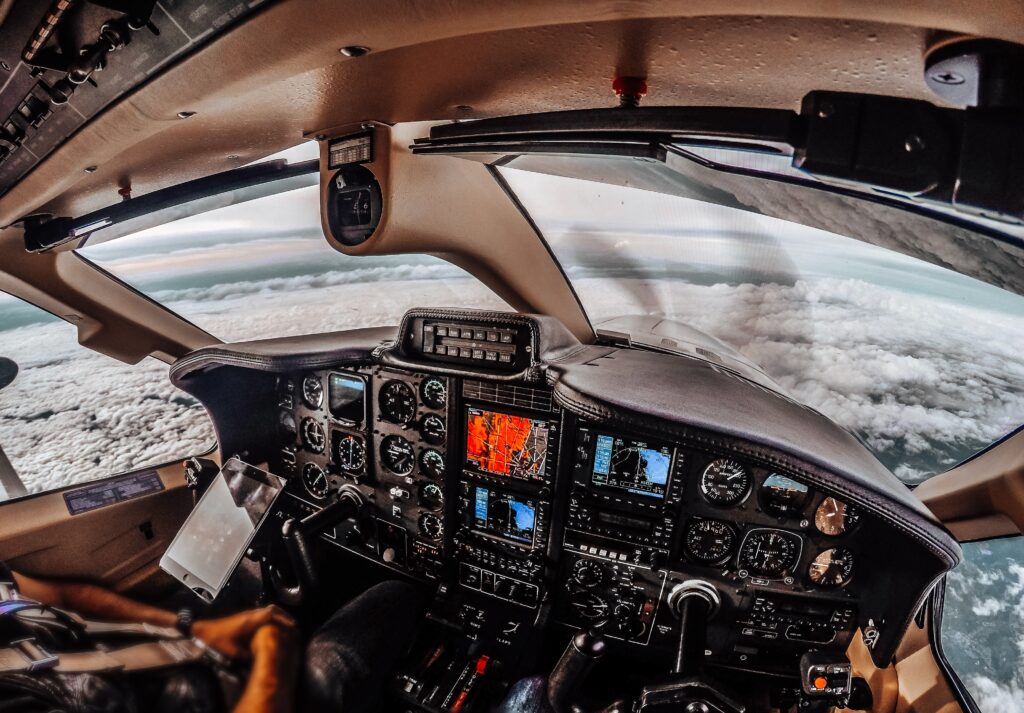
Let me tell you another true story.
As I was driving home a couple of days ago from having dinner with some friends I was passing by the local airport close to where I live.
There was a plane landing and the Approach Lighting System (ALS) was active.
An Approach Lighting System (ALS) is a lighting system installed on the approach end of an airport runway and consists of a series of light bars, strobe lights, or a combination of the two that extends outward from the runway end.
An ALS usually serves a runway that has an Instrument Approach Procedure (IAP) associated with it and allows the pilot to visually identify the runway environment and align the aircraft with the runway upon arriving at a prescribed point on an approach.
Watching the plane follow the ALS to the runway made me think about something. I have a pilot license for fixed wing aircraft (i.e., airplanes).
My designation is private pilot, single engine, land, with instrument training. What this means is that I can legally fly a plane with one engine and take off and touch down on land. Taking off and touching down on water requires a totally different certification.
Most of my flying was under Visual Flight Rules (VFR). Visual Flight Rules (VFR) are a set of regulations under which a pilot operates an aircraft in weather conditions generally clear enough to allow the pilot to visually see where the aircraft is going (i.e., not obstructed by clouds, fog, etc.).
The VFR pilot is required to “see and avoid” obstacles and other aircraft.
When operation of an aircraft under VFR is not safe, because the visual cues outside the aircraft are obscured by weather, Instrument Flight Rules (IFR) must be used instead.
I also did some of my flying under Instrument Flight Rules (IFR).
Instrument Flight Rules (IFR) are a set of rules and regulations established to govern flight under conditions in which flight by outside visual reference is not safe because the pilot cannot visually see anything (i.e., obstructed by clouds, fog, etc.).
IFR flight depends upon flying by reference to instruments in the airplane cockpit and navigation is accomplished by reference to electronic signals instead of by visual references under VFR.
When I was in ground school to learn the IFR rules and regulations, my instructor was a retired military pilot who was flying for a large commercial airline. My IFR instructor taught us various weather scenarios that commonly happen in IFR weather conditions such as ice developing on the wings of the plane destroying the wings ability to provide lift.
My IFR instructor would always say that if such weather scenarios got serious enough during flight, that we would “touch down” somewhere other than at an airport.
However, my IFR instructor would never would ever say we were going to “crash.”
According to a US Federal Aviation Administration (FAA) document, “spatial orientation” is one of the most important factors in successful IFR flying.
According to that FAA document: “Spatial orientation defines our natural ability to maintain our body orientation and/or posture in relation to the surrounding environment (physical space) at rest and during motion. Genetically speaking, humans are designed to maintain spatial orientation on the ground. The three-dimensional environment of flight is unfamiliar to the human body, creating sensory conflicts and illusions that make spatial orientation difficult, and sometimes impossible to achieve.”
Spatial orientation in IFR flight is difficult to overcome because the motion (e.g., orientation, direction, velocity, momentum, etc.) of the aircraft differs from a motion perceived by a pilot sensory inputs (i.e., sight, feel, sound, etc.). Any differences or discrepancies between the pilot’s sensory inputs result and the motion of the aircraft results in a sensory mismatch that can produce illusions and lead to spatial disorientation.
The spatial disorientation can lead to illusions causing the pilot thinking the plane is inverted, the nose of the plane is pointed up or pointed down when it is not, or causing the pilot to enter a “graveyard spiral,” or “graveyard spin,” which will cause the aircraft to “touch down” somewhere other than the airport.
We live in a three-dimensional (3D) world in which we rely on our 5 senses of sight, hearing, touch, smell, and taste.
Just like in IFR flight, in any stressful situation you are facing relying solely on your 5 senses can produce illusions and disorientation.
For example, if you are feeling fearful, in many instances your feelings of fear are based on illusions as one acronym for FEAR, is False Evidence Appearing Real.
Get additional insights on overcoming IFR conditions in your own life from the Out There on the Edge of Everything® Podcast.
If the people, circumstances or events in your life are causing you to fly under IFR conditions how can you avoid illusions and spatial orientation to touch down somewhere other at your desired end point?
- Rely on your Intuition. Your intuition is your First Sense and is your own internal guidance and instrument system. Your intuition is the sense you should always rely on first before your other 5 senses when you are facing IFR conditions in your life in which you cannot see clearly. Your intuition is that gut-feeling, that warm feeling in your heart-space, that ah-hah moment or something that just pops into your head, without you having been thinking about it, but is something you just know, is true and correct. Your intuition is your connection to Divine Energy, the higher dimensions outside the 3rd dimension. Your Intuition provides you with clear, viable and peaceful solutions to challenges you are currently facing in your life. Your Intuition provides you with inspired, specific and direct actions you can take so you can create forward movement.
- Adjust your Attitude. Attitude is defined as “a settled or ingrained way of thinking or feeling about someone or something, typically one that is reflected in a person’s behavior.” Attitude is also defined (with respect to an aircraft) as “an orientation with respect to a set of reference axes to an artificial horizon.” Aircraft include an instrument called an attitude indicator that visually shows your attitude orientation in the aircraft and is an important instrument that is used in IFR conditions. Practice present moment awareness to initiate change to your own attitude indicator. The past is gone and the future has not yet occurred. So focusing on either the past or future is nothing but a distraction and a waste of energy. The present moment is the point between the past and the future. It is the point at which you can co-create the life you truly desire. It is the point that keeps you connected energetically to your intuition and everyone and everything in your environment. To practice present moment awareness, breathe slowly and rhythmically, be still and become aware what messages your intuition is sending you. Experience everything from inside your body first, then the environment your body is in. Be aware of and see all things around you without judgement. This puts you in a calm present moment state from which you can adjust your attitude indicator to navigate the IFR conditions you are facing in your life using your intuition.
- Trust. When an outcome in any life situation you are facing is uncertain and includes circumstances beyond what you can control and you are facing IFR conditions, you must use your intuition, adjust your attitude indicator and have trust. When you trust, you open yourself up to the energy of a Higher Power and Divine Energy an energy field based in part on the vibration of love and one in which all things are possible and happen in ways you can never imagine. Trust requires you to have faith in and a belief in a Higher Power and at the same time a faith and belief within yourself that the outcome you desire will happen, even though you cannot currently experience it with your own five senses or because of the IFR conditions you are facing in your own life.
When you are facing IFR conditions in your life, relying on your intuition, adjusting your attitude and trusting will help you create a positive impact in your own life and allow you to touch down at your desired location co-creating a life you truly desire.
Out There on the Edge of Everything® …
Stephen Lesavich, PhD
Copyright © 2021, by Stephen Lesavich, PhD. All rights reserved.
Certified solution-focused life coach and experienced business coach.

Award-winning and best-selling Author, Entrepreneur, Visionary, CEO of 2 different companies, Attorney, Tech Expert, Certified Solution-Focused Life Coach, Experienced Business Coach.

